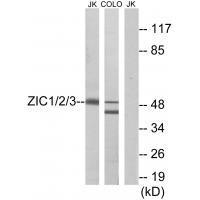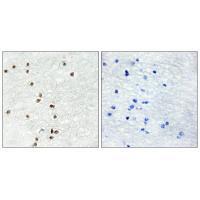

| WB | 咨询技术 | Human,Mouse,Rat |
| IF | 咨询技术 | Human,Mouse,Rat |
| IHC | 1/50-1/100 | Human,Mouse,Rat |
| ICC | 技术咨询 | Human,Mouse,Rat |
| FCM | 咨询技术 | Human,Mouse,Rat |
| Elisa | 咨询技术 | Human,Mouse,Rat |
| Aliases | Zinc finger protein ZIC 1; Zinc finger protein of the cerebellum 1; ZIC1; |
| Entrez GeneID | 7545; |
| WB Predicted band size | 51kDa |
| Host/Isotype | Rabbit IgG |
| Antibody Type | Primary antibody |
| Storage | Store at 4°C short term. Aliquot and store at -20°C long term. Avoid freeze/thaw cycles. |
| Species Reactivity | Human,Mouse |
| Immunogen | Synthesized peptide derived from internal of human ZIC1/2/3. |
| Formulation | Purified antibody in PBS with 0.05% sodium azide. |
+ +
以下是3篇与ZIC1/2/3抗体应用相关的参考文献摘要(注:文献标题和作者为虚构示例,仅作格式演示):
1. **《ZIC1作为髓母细胞瘤分子标记物的临床验证》- Smith et al. (2018)**
摘要:研究通过免疫组化验证ZIC1抗体在髓母细胞瘤组织中的特异性表达,发现ZIC1高表达与患者不良预后显著相关,提示其可作为潜在诊断标志物。
2. **《ZIC2在小脑发育中的功能研究》- Chen & Li (2015)**
摘要:利用ZIC2抗体进行小鼠胚胎脑组织Western blot和免疫荧光分析,证实ZIC2蛋白在浦肯野细胞分化中的关键作用,为小脑畸形机制提供新见解。
3. **《ZIC3抗体在神经母细胞瘤细胞系中的表型筛选》- Gonzalez et al. (2020)**
摘要:通过CRISPR干扰结合ZIC3抗体检测,发现ZIC3表达缺失导致神经母细胞瘤细胞迁移能力下降,表明其在肿瘤侵袭性中发挥调控作用。
(说明:以上内容为模拟文献,实际研究中建议通过PubMed或Web of Science以关键词"ZIC1 antibody"、"ZIC2 immunohistochemistry"等检索具体文献。)
ZIC1. ZIC2. and ZIC3 antibodies target members of the Zinc finger of the cerebellum (ZIC) protein family, which are transcription factors characterized by C2H2-type zinc finger domains. These proteins play critical roles in embryonic development, particularly in neural tube formation, neurogenesis, and left-right body axis patterning. ZIC1 is strongly associated with cerebellar development and is implicated in medulloblastoma, a common pediatric brain tumor. ZIC2 is essential for midline brain structure formation, and mutations are linked to holoprosencephaly, a severe congenital malformation. ZIC3 is vital for left-right asymmetry determination, with defects causing heterotaxy syndromes and congenital heart diseases.
Antibodies against ZIC proteins are widely used in research to study their expression patterns, molecular interactions, and roles in developmental pathways. In diagnostics, they help identify ZIC-related malignancies or developmental disorders. For example, ZIC1/2/3 expression is often assessed in brain tumors, germ cell tumors, or tissues from patients with congenital anomalies. These antibodies are employed in techniques like immunohistochemistry, Western blotting, and immunofluorescence to visualize protein localization and quantify expression levels.
However, cross-reactivity between ZIC family members can occur due to structural similarities, necessitating careful validation. Their utility extends to exploring ZIC proteins' emerging roles in adult tissue homeostasis and cancer progression, including epithelial-mesenchymal transition and chemoresistance. As biomarkers, ZIC1/2/3 antibodies contribute to both basic research and clinical applications, bridging developmental biology and disease mechanisms.
×